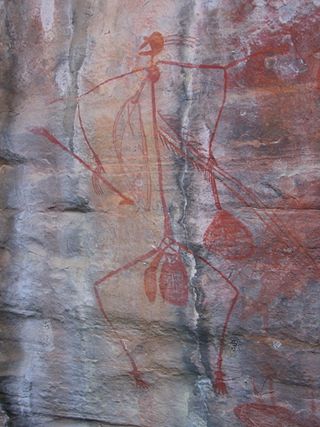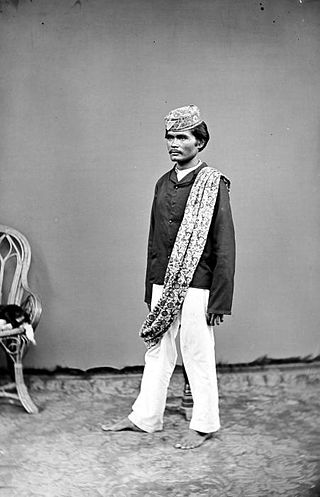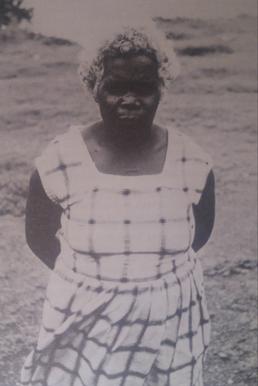See also
- Makassan contact with Australia
- Trepanging, the act of collecting sea cucumber
- Patorani and padewakang, two types of perahu used for trepanging by Makassan
- Yolngu
Baijini are a mythical people mentioned in the Djanggawul song cycle of the Yolngu people, an Aboriginal Australian people of Arnhem Land in the Northern Territory. Many speculations have arisen that try to link these mythical culture-bearers with historical immigrants from either China directly or Southern Asia.
According to Garry Trompf, the word "Baijini" itself is said to have been derived from a Makassarese root with the meaning "women". [1] [lower-alpha 1] Joseph Needham wondered if the word Baijini itself might not have been derived from Chinese bái rén (白人, "white people" (i.e., those with lighter skin than the Australian natives), běirén (北人, "northern people"), or even běijīngrén (北京人, "people from Beijing"). [2]
In the Djanggawul song-cycles, it is told how, in the legendary land of Bu'ralgu somewhere beyond Groote Eylandt, there once lived three eternal beings called the Djanggawul: a brother, and his elder and younger sisters, together with a fourth man, Bralbral. Bu'ralgu itself had been a stepping stone in their journey south from an even more distant land. The four, after a series of ceremonies, rowed out from the island and, after several days, came to Arnhem Land, and followed the coast to Yalangbara (Jelaŋbara, aka Port Bradshaw). [3] They then travelled overland until they came to Wabilinga Island and it was there that they came across the Baijini folk, cooking trepang at a site still marked by a tamarind grove. The Djanggawu claimed this place as their own, asking the Baijini to move off, which they did, either to the other side of the island or to the mainland. [4]
The dreamtime landing site at Jelaŋbara was, according to the song cycle, also, later, a Baijini settlement. [3]
It has been argued that the account of the Baijini in the Aboriginal folklore are in fact a mythological reflection of the experiences of some Aboriginals who have traveled to Sulawesi with the Macassans and came back. [5] If there was indeed an historical reality behind the Baijini mentioned in Yolŋu myth, the origin and timing of those Asians who would have served as the prototype for this mythological people remains lost in the past. [6] It has been suggested that they may be identified with the Sama-Bajau, [7] or Sea Gypsies, the fishing folk of South East Asia who traveled with their families. [8]
The Australian anthropologist Ronald Berndt studied the people of Yirrkala and Milingimbi Island in the late 1940s. In his work on their mythic traditions, published in 1952 he wrote:
the Baijini, although partially mythological are, rather, historical; for they are said to have been pre-Macassans, primarily traders and aliens to the coast, and not in any way creative as were the Djanggawul. They are, however, treated in the myth as if contemporary with these Ancestral Beings. [9]
Berndt added that similar to the Makassan trepang fishermen in Australia known to the historians, the Baijini of the Djanggawul myth are said to be "cooking trepang, where the tamarind trees stand to-day". [10] Tamarind trees are thought to have been introduced to Australia by the Makassans. According to interpretations of the legends, the Baijini not only built stone houses (balapathu) [11] but also cultivated rice paddies. [12] [13]
The following year. the sinologist C.P. FitzGerald mentioned the possibility of pre-European Chinese visits to Australia in an article, which conjecture a possible early Chinese presence in northern Australia, by mentioning a Chinese statue which had been dug up in 1879 near Darwin.
Fitzgerald's allusion was a figurine which had been dug up 4 feet down among the roots of a banyan tree by Chinese natives, under the direction of a Public Works superintendent, Mr. Strawbridge, who was overseeing the clearance of dense jungle for the construction of a road at a site called Doctor's Gully in Palmerston just outside of the town of Darwin in 1879. [14] [15] [16] The gully leads down to a sandy cove, and is one of the two sites where fresh water can be found in Darwin. [17] The figurine was mounted on an animal, identified as either a gazelle or antelope. It came into the possession of Thomas Worsnop who reproduced a drawing of it in his 1897 work on Aboriginal arts and manufactures. Worsnop described it as fashioned from a type of jade, though later scholars have stated it is made of soapstone, [18] and stated that all inquiries he had made to determine what it represented had failed to clarify its origin. [19] Eventually, In a paper read before the Royal Society of South Australia on 8 March 1928, [20] Norman Tindale identified it as a Chinese deity from the Tang dynasty, [18] a high backdating which elicited Fitzgerald's skepticism. [21] The deity in question, associated with Canopus, is the Old Man of the South Pole, Shòu lǎo, (壽老), the Chinese god of longevity who was one of the Sānxīng , or three stellar deities, in Chinese religion.
Peter Worsley took up Fitzgerald's remark in 1955, making a succinct synthesis of the overall scholarship regarding pre-European contacts with northern Australia. In his essay, he mentioned the Baijini myths current among the Yolngu:
In eastern Arnhem Land, moreover, the aborigines are quite categorical in their statements that the Macassarese were preceded another people they term the Baijini. These people were different from the later Macassarese, though like the Macassarese, they came for the purpose of collecting trepang, a sea-slug which abounds in the shallow waters off the Arnhem Land coast.. The Baijini had an advanced technology: they possessed hand-looms, were agriculturalists, and built huts during their stays in Australia. One of the more interesting comments made about the Baijini is a reference to their light-coloured skins. Whilst it is possible that these people may have been Chinese, the trade in trepang was usually carried out by non-Chinese, the Chinese middlemen coming into the picture at Koepang and other such markets. Fitzgerald suggests that any Chinese voyages would most likely have been scientific and exploratory expeditions rather than trading expeditions. The Baijini, then, may have been another Indonesian people, and not necessarily Chinese.' [22]
J.V.G. Mills, in a note to a translation of a Ming dynasty account by Ma Huan concerning Chinese voyages at that time, suggested that if, of the many Asian people whose visits might have engendered a legend about the Baijini, they were Chinese, the likely explanation would be that it referred to some vessel detached from the fleet of Zheng He, which would have sailed south from Timor. [23]
Anthropologist Ian McIntosh has interpreted the cycle's mention of the Baijini as a fictional history devised by the Yolngu, centered on Warramiri clanland at Dholtji [lower-alpha 2] in the Cape Wilberforce peninsula. According to this theory, the function of the Baijini stories was to provide a mythic charter to govern trade relations, originally, with Asians. [24] McIntosh argues that Birrinydji, in his twin roles as a powerful sea-captain and blacksmith in the Dreamtime, was the key figure in legends that encode the problems arising from primal encounters with outsiders. [25] It was he who is said to have drawn by his magnetic presence and actions far-flung peoples to migrate to Arnhem Land's coasts. The name 'Birronydji' itself appears to reflect a term for freebooting Portuguese crusaders. [26]
This Birrinydji was said to have the power to morph at will from being white to black. His people wore sarongs, distinctive whale-tail shaped hats and their craft flew a flag banded with blue, red and blue stripes. These features are correlated by McIntosh with a Macassan story that narrates how a group of Gowans sailed south to find refuge in Arnhem Land after the Macassan Kingdom of Gowa was attacked by a joint Dutch-Bugis force in 1667. [27] Yet elements of still earlier encounters seem to be embedded in these tales since what appear to be allusions to Islamic and Portuguese visits are also present in the myth cycle. For example, a moon-dwelling deity called 'Allah' is alluded to in funerary rites. Pre-Macassan men in 'mirrors' (shining armour) are said to have rallied troops on Dholtji's shore and the Warramiri clan elders referred to Dholtji as Mecca. [26]
Beneath these possible traces in myth suggestive of some pre-modern contact with South Asian traders, the Baijini strarum of legend, in this light, would appear to evoke specifically an older pre-Macassan order. One index of this is that Dholtji songs fail to mention precisely what the Macassan traders sought, trepang. [28] The Birrinydji cycle speaks of a tall bearded people with a king, Luki, the admiral of Birrinydji's fleet Lela and his boat's captain Djammangi. Whatever the historical reality, McIntosh concluded, functionally in these Yolngu traditions, the contrast between a golden age of wealth, reciprocity and law-giving, and a subsequent period of seafaring Macassan trepang hunters, functions in counterpoise to mediate between two distinct realms, the sacred and profane spheres to enable thinking about their world's relationship with a foreign order. The contrast between the two modes would serve as a metaphorical system for negotiating forms of reconciliation between their traditional order with the exclusive land rights of clan territory underwritten by sacred stories of origins, and the modern world of the whites who seek purchase on their land and access to Arnhem Land resources. [29]
The Chinese origin hypothesis for the Baijini has been recently revived by the American journalist Louise Levathes. [30]
The Djang'kawu, also spelt Djanggawul or Djan'kawu, are creation ancestors in the mythology of the Yolngu people of Arnhem Land in the Northern Territory of Australia. It is one of the most important stories in Aboriginal Australian mythology, and concerns the moiety known as Dhuwa.
Baralku, also written Burralku or Bralgu, is a place connected with creation ancestors in the mythology of the Yolngu people of Arnhem Land in the Northern Territory of Australia. It is referred to as island of the dead, and the place where the ancestors known as Djanggawul (Djan'kawu) originated, before travelling by canoe to Yalangbara, where they gave birth to the Rirratjingu clan.
Kunapipi, also spelt Gunabibi, ('womb') is a mother goddess and the patron deity of many heroes in Australian Aboriginal mythology.
The Wawalag sisters, also written as WauwalukWawilakWaggilak, Wagilag, or Wawalik, are ancestral creator beings whose story is part of "the most widespread" sacred rituals in the Aboriginal culture from Arnhem land, Northern Territory, Australia. Their story takes place in Dreamtime, a period of time in Aboriginal belief where ancestral beings created the land as well as the social and linguistic structures in it. The sisters are said to have helped draw linguistic and social differences amongst the clans in Arnhem Land, but the ceremonies associated with their stories create cultural unity.

Arnhem Land is a historical region of the Northern Territory of Australia, with the term still in use. It is located in the north-eastern corner of the territory and is around 500 km (310 mi) from the territory capital, Darwin. In 1623, Dutch East India Company captain Willem Joosten van Colster sailed into the Gulf of Carpentaria and Cape Arnhem is named after his ship, the Arnhem, which itself was named after the city of Arnhem in the Netherlands.

The Yolngu or Yolŋu are an aggregation of Aboriginal Australian people inhabiting north-eastern Arnhem Land in the Northern Territory of Australia. Yolngu means "person" in the Yolŋu languages. The terms Murngin, Wulamba, Yalnumata, Murrgin and Yulangor were formerly used by some anthropologists for the Yolngu.
The Gove Peninsula is at the northeastern corner of Arnhem Land in the Northern Territory of Australia. The peninsula became strategically important during World War II when a Royal Australian Air Force base was constructed at what is now Gove Airport. The peninsula was involved in a famous court case known as the Gove land rights case, when local Yolngu people tried to claim native title over their traditional lands in 1971, after the Australian Government had granted a mineral lease to a bauxite mining company without consulting the local peoples. Today the land is owned by the Yolngu people.

Makassar people from the region of Sulawesi in Indonesia began visiting the coast of northern Australia sometime around the middle of the 18th century, first in the Kimberley region, and some decades later in Arnhem Land. They were men who collected and processed trepang, a marine invertebrate prized for its culinary value generally and for its supposed medicinal properties in Chinese markets. The term Makassan is generally used to apply to all the trepangers who came to Australia.

The prehistory of Australia is the period between the first human habitation of the Australian continent and the colonisation of Australia in 1788, which marks the start of consistent written documentation of Australia. This period has been variously estimated, with most evidence suggesting that it goes back between 50,000 and 65,000 years. This era is referred as prehistory rather than history because knowledge of this time period does not derive from written documentation. However, some argue that Indigenous oral tradition should be accorded an equal status.
The History of the Northern Territory began over 60,000 years ago when Indigenous Australians settled the region. Makassan traders began trading with the indigenous people of the Northern Territory for trepang from at least the 18th century onwards, and possibly 300 years prior to that.

Yolŋu Matha, meaning the 'Yolŋu tongue', is a linguistic family that includes the languages of the Yolngu, the indigenous people of northeast Arnhem Land in northern Australia. The ŋ in Yolŋu is pronounced as the ng in singing.

Trepanging is the act of collection or harvesting of sea cucumbers, known in Indonesian as trepang, Malay těripang, and used as food. The collector, or fisher, of trepang is a trepanger.

The Makassar or Makassarese people are an ethnic group that inhabits the southern part of the South Peninsula, Sulawesi in Indonesia. They live around Makassar, the capital city of the province of South Sulawesi, as well as the Konjo highlands, the coastal areas, and the Selayar and Spermonde islands. They speak Makassarese, which is closely related to Buginese and also a Malay creole called Makassar Malay.
The Bininj are an Aboriginal Australian people of Western Arnhem land in the Northern Territory. The sub-groups of Bininj are sometimes referred to by the various language dialects spoken in the region, that is, the group of dialects known as Bininj Kunwok; so the people may be named the Kunwinjku, Kuninjku, Kundjeyhmi (Gundjeihmi), Manyallaluk Mayali, Kundedjnjenghmi and Kune groups.
The Nunggubuyu are an Aboriginal Australian people of eastern Arnhem Land in the Northern Territory.

Wurrwurrwuy stone arrangements is a heritage-listed indigenous site at Yirrkala, Northern Territory, Australia. It is also known as Wurrwurrwuy. It was added to the Northern Territory Heritage Register on 15 August 2007 and to the Australian National Heritage List on 9 August 2013.

Mondalmi was an Aboriginal activist and cultural informant from Australia.
Wonggu Mununggurr (c.1880–1959) was an Aboriginal Australian artist and leader of the Djapu clan of the Yolngu people of northeast Arnhem Land in the Northern Territory of Australia.
Mungurrawuy Yunupingu (c.1905–1979) was a prominent Aboriginal Australian artist and leader of the Gumatj clan of the Yolngu people of northeastern Arnhem Land in the Northern Territory of Australia. He was known for his bark paintings.

The Javanese presence in Australia has been reported by native Southeast Asian and European people over several centuries. The most renowned record is from the itinerary of Chiaymasiouro, king of Demak, and Declaraçam de Malaca e India Meridional com o Cathay by Manuel Godinho de Eredia. Chiaymasiouro describes a land called LucaAntara in Southeast direction of Java, which Eredia coined the term India Meridional. According to Chiaymasiouro's accounts, a subgroup of Javanese people already settled in those lands, but when Eredia's servant went to LucaAntara in 1610, the land had seemingly been abandoned.